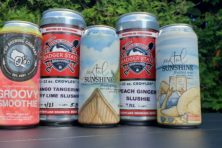Suds with Sophie: Celebrate Oktoberfest at Home
- Share
- Tweet
- Pin
- Share

by Sophie Nelson, [email protected]
Even though Oktoberfest events – from local shindigs to the weeklong event in Germany – are canceled this year, that doesn’t mean you can’t still celebrate at home! Many breweries nationwide are brewing up their version of an “Oktoberfest” beer, and some German imports are on the shelves as well.
Let’s start by nailing down exactly what an “Oktoberfest” beer is. Contrary to what advertisements, names and basically any other mainstream information tells you, Oktoberfest is not a style of beer. All beers that call themselves Oktoberfests should be lagers with an amber, bready malt character, although the level of these malt characters can vary greatly.
In Germany, the name “Oktoberfest” is an appellation rather than a distinct style, meaning that only beers made in Munich can call themselves Oktoberfests. In the U.S., of course, this rule does not exist.
The style of Oktoberfest brews is most commonly a Märzen, but it can also be a Vienna lager or festbier. Vienna lagers are all but extinct in Germany and use a lighter Vienna malt rather than the darker Munich malts of Märzen beers, but they are otherwise very similar. Festbier is the most common style served at the Munich Oktoberfest, and it’s lighter and less filling than Märzens and Vienna lagers.
Now that we’ve got some history out of the way, let’s get to some beer! For this tasting, a few friends and I grabbed as many “Oktoberfest” styles as we could find easily. We ended up with 13 different beers (with two repeats in different packaging). We tasted each of these one at a time, then placed the empty cans or bottles in order of preference. The beers we tried in order from favorite to least favorite were: Revolution Brewing Company’s Oktoberfest, 3 Sheeps Brewing Company’s Oktoberfest (can), Ayinger Privatbrauerei’s Oktober Fest-Märzen, Bitburger Brauerei’s Festbier, 3 Sheeps Brewing Company’s Oktoberfest (bottle), Ahnapee Brewery’s Oktoberfest, Hacker Pschorr’s Oktoberfest-Märzen, Bell’s Brewery’s Oktoberfest, New Glarus Brewing Company’s Staghorn, Jacob Leinenkugel Brewing Company’s Oktoberfest (bottle and can), and Badger State Brewing Company’s Okt-Ski.
Revolution Brewing Company’s Oktoberfest is full bodied and flavored while still being drinkable. There’s a nice bread crust sort of malt, with a little toasty caramel character thrown in. It finishes very clean and with a touch of molasses at the end.
3 Sheeps Brewing Company’s Oktoberfest is one where the packaging made all the difference. The can had a nice roast and caramel malt, with a smooth body and light sweetness to balance. The bottle, however, tasted a bit oxidized and was much lighter. It even had a watery quality that made it rank lower.
Ayinger Privatbrauerei’s Oktober Fest-Märzen is a real German competitor with smooth, toasty malt; almost a bit of a dark fruit flavor; and a very clean finish. There was a little pleasing butterscotch and great light, toasty flavors.
Bitburger Brauerei’s Festbier is a real festbier, or a lighter version consumed at the Munich event. It’s more amber in color than an authentic, meaning that the batch was adapted for American tastes. It had a good lighter flavor and was more “easy drinking” than some of the other competitors. There was a light bitterness that wasn’t always present in the others, but it was still very drinkable.
Among the ones that placed below these, there were issues ranging from overly sweet, cloying tastes – such as the Staghorn from New Glarus Brewing Company – or just too light and thin, such as the Okt-Ski from Badger State Brewing Company or the Hacker Pschorr Oktoberfest-Märzen. Others just weren’t as enjoyable overall. One bottled import by Paulaner had to be disqualified for excessive oxidation that clouded the real flavor.
Of course, everyone has different tastes, and within our small tasting group, there were different opinions. So try some for yourself this Oktoberfest season to see which ones you like best!


